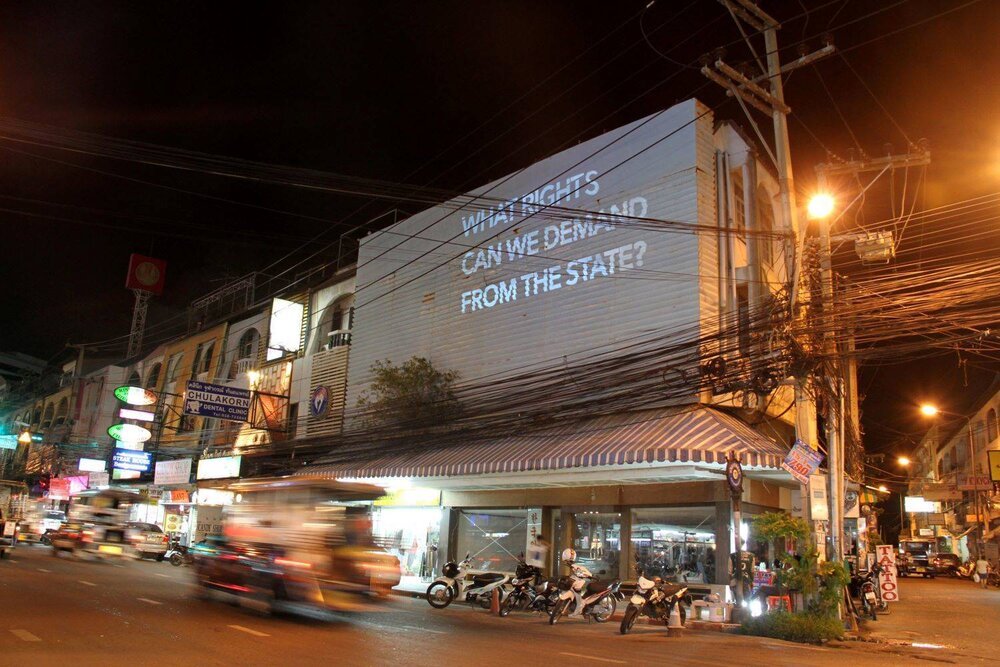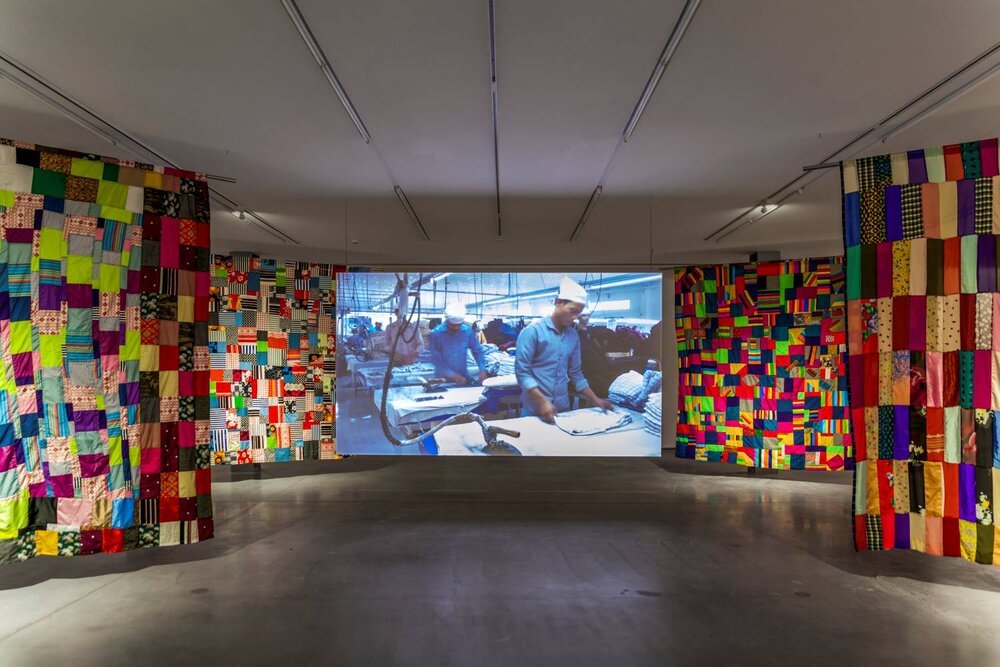We Are Not Alone In This World
Power and discourse in the work of Piyarat Piyapongwiwat
By Blake Palmer
Over the course of her ten-year practice, Thai artist Piyarat Piyapongwiwat has consistently produced work that amplifies the voices of the “unheard and unwanted.”1 She has confronted such issues as sex, gender, class, labour, immigration, resource extraction, and government. While unpacking these multilayered and overlapping issues through documentary and narrative film, photography, installation, sculpture, audio, and mixed media, she offers an enduring focus on communities that have been marginalised.
Through the examination of four video works by Piyapongwiwat, ‘Messages From Nowhere to Nowhere’ (2015), ‘Mute Conversations’ (2016), ‘Fabric’ (2017), and ‘Particle’ (2019), we will trace a focused genealogy of the artist’s efforts to provoke dialogues that challenge normalised dynamics and engender awareness of and empathy towards those who suffer under these dynamics.
Piyarat Piyapongwiwat, ‘Messages From Nowhere to Nowhere’, 2015, video, photographs, 11 min 19 sec and dimensions variable. Image courtesy of the artist.
Piyapongwiwat’s text-based video work, ‘Messages From Nowhere to Nowhere’, utilises the culturally diasporic backdrop of Pattaya City, Thailand to examine common threads of discontent with local government shared by its diverse residents. These collected messages, gathered from private conversations, are projected into the public sphere, onto walls in busy urban spaces in and around Pattaya City, thus creating opportunities for the community to cross lines of culture, language, and social taboo to discuss ways in which they believe their government has failed them.
Some of these are relatively light requests like, “I would like to have recreational space in the middle of the city.” Others, however, address the presence of child labour, human trafficking, and other serious problems facing Pattaya City’s population. Most poignant are the open questions, asked by anonymous people and addressed to no one. “Why do we have to pay bribes,” “Why don’t we make prostituation legal,” and as if in summary, “What rights can we demand from the State?”2
Piyarat Piyapongwiwat, ‘Mute Conversations’, 2016, video, photographs, 12 min 4 sec and dimensions variable. Image courtesy of the artist.
In her 2016 work, ‘Mute Conversations’, Piyapongwiwat employs a similar form to give public space for private dialogues gathered from conversations with Thai immigrants living in Yokohama, Japan. Once again, by projecting these statements along well-trafficked pedestrian routes in Yokohama, she publicly confronts communities with the unguarded honesty that is normally reserved for intimate conversations among friends, and in doing so, she creates a bridge between members of this community who might not otherwise achieve such uninhibited dialogue.
These projected statements display a spectrum of pride and fear typical to the immigrant experience in many places. Concerns about visa status, limited work availability, and the delicate task of balancing intersectional identities in an unfamiliar culture—“I don’t dare identify myself as being gay here”3—are interwoven with earnest expressions of deep connection to a new home and the intercultural families that have been forged there. “I feel harmony with people here,” says one anonymous person.4
In both of these works, ‘Messages From Nowhere to Nowhere’ and ‘Mute Conversations’, Piyapongwiwat undertakes to affect the dominant discourse, by opening up spaces for marginalised voices within it that critique, trouble, and sometimes outright resist the power of that dominant discourse. Foucault understands discourse as that which “transmits and produces power.” But discourse not only “reinforces it, but also undermines and exposes it, renders it fragile and makes it possible to thwart it.”5 For this reason he writes that “[w]here there is power, there is resistance, and yet, or rather consequently, this resistance is never in a position of exteriority in relation to power.”6 Entangled with intersubjectively shared social practices, discourse constitutes power in the form of subjectivity and knowledges, hence Foucault’s frequent invocation of power/knowledge as undisentangleable from one another, such that relations of power inhere in systems of constitutive knowledge, which shape the social practices that embody and instantiate them.
Through her work, Piyapongwiwat brings marginalised discourse into a space of contrast to culturally dominant discourses. She seeks to create opportunities for discourse and power relations to be constituted in a way that is more empathetic and inclusive towards those who fall outside the normalized paradigms of the dominant culture, ethnicity, and sexuality, or even to shift what is considered normal or possible by participants within the discourse.
Piyarat Piyapongwiwat, ‘Fabric’, 2017, video, patchwork installation, 19 min 41 sec, dimensions variable. Image courtesy of MAIIAM Contemporary Art Museum.
In her 2017 work ‘Fabric’, Piyapongwiwat continues her exploration of margins, this time through documentary. In this work, she focuses her lens on textile labourers across Southeast Asia where much of the world’s clothing is produced at low cost and under poor labour conditions. A Japanese woman’s voice plays over the video, reciting a first person account of the struggles of Japanese textile workers from the Meiji era. The similarities in this spoken narrative and the conditions of the textile workers in the video demonstrate how little the plight of poor industrial workers has changed.
The Southeast Asian labourers are shown to reside in small, poorly-furnished, single-room apartments. At night they step outside these company-provided workers’ accommodations to drink and laugh together. This joyful community spirit contrasts starkly in the following scenes wherein labourers rigidly and mechanically focus on repetitive manual tasks—sorting, cutting, and sewing without acknowledgment of one another despite their crowded proximity. The Japanese narrator speaks from the past, echoing the sentiments of the silenced labourers: “If he caught us saying even one word to the person next to us, he would scold us.”7
The labourers are systematically dehumanised by the substandard conditions of their working and living environments, as well as through policies that militate against workplace socialising, and keep the labourers isolated from one another. This atomisation also conveniently makes it harder for relations of solidarity to emerge amongst co-workers, which helps maintain the status quo.
Piyarat Piyapongwiwat, ‘Particle’, 2019, video installation, sculptures (quicklime, cement, sand), painting (cement packaging, threads, clay, glue, acrylic colour, quicklime), 18 min 54 sec. Image courtesy of Karin Mongkonphan.
Documentary elements are used again in Piyapongwiwat’s recent video work, ‘Particle’ (2019), but augmented by a fictive narrative that is interwoven throughout. Here she also examines industrial exploitation, but focuses on the effect of extractive capitalism on a community in Cambodia. This community has been fenced off from the mountain they have relied on for generations to provide them with food, medicine, and money, so that the limestone can be extracted for use in urban development by the Cambodian-Thai owned Kampot Cement Company. By connecting the audience through intimate interviews with these villagers and laborers, Piyapongwiwat amplifies the voices of the marginalised.
Foucault’s concept of biopower can help illuminate Piyapongwiwat’s examination of the marginalized labourers in both ‘Fabric’ and ‘Particle’. Biopower entails a mode of “political rationality which takes the administration of life and populations as its subject.”8 It is power that constitutes bodies in particular ways conducive to the governance of processes of living and dying under the pretext of a notion of “progress” uncritically defined in the dominant discourse. In the pursuit of this purported progress, actions that might otherwise be deemed cruel or inhumane—as with the poor conditions of the labourers in ‘Fabric’ or the fencing off of indigenous land in ‘Particle’—are justified or at least permitted in order to facilitate “the controlled insertion of bodies into the machinery of production and the adjustment of the phenomena of population to economic processes.”9
Piyarat Piyapongwiwat’s practice of offering platforms for the voices of marginalised groups who are excluded helps provide a pathway through which knowledge and understanding can be brought into resistance against harmful and repressive expressions of power/knowledge.
Piyarat Piyapongwiwat’s most recent work, ‘Where Echoes Never End’, a video essay summarizing her projects from the past decade, is showing at Gallery VER Project Room, Bangkok until March 14th. For more information, visit galleryver.com
1 Lyla Phimanrat, Messages From Nowhere to Nowhere, 2015, accessed February 21, 2020, http://www.piyaratpiyapongwiwat.com/messages-nowhere-nowhere-0.
2 Piyarat Piyapongwiwat, Messages From Nowhere to Nowhere, 2015.
3 Piyarat Piyapongwiwat, Mute Conversations, 2016.
4 Ibid.
5 Michel Foucalt, The History of Sexuality, Vol 1: An Introduction. Translated by Robert Hurley. (Harmondsworth: Penguin, 1992), 101.
6 Ibid.
7 Piyarat Piyapongwiwat, Fabric, 2017.
8 Rachel Adams, “Michel Foucault: Biopolitics and Biopower,” Critical Legal Thinking, May 10, 2017, http://criticallegalthinking.com/2017/05/10/michel-foucault-biopolitics-biopower/
9 Foucault, History of Sexuality, 140-1.














